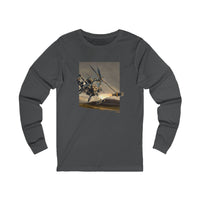
Apache - Long Sleeve Tee
$32.00
From air power artist Peter Van Stigt this illustration shows the fearsome Apache attack helicopter in action. Peter is a commercial digital artist who is an aviation fanatic, producing aviation artwork sold around the world.
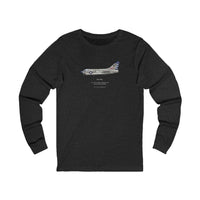
A-7 Corsair II VA-93 - Long Sleeve Tee
$32.00
The Blue Blazers or VA-93 Attack Squadron was formed in 1954 operating the F9F-2 Panther, A-4 Skyhawk and then the A-7A. The Squadron saw action in Korea and Vietnam.
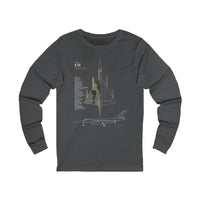
B-58 Hustler - Long Sleeve Tee
$32.00
The Hustler was developed during the 50s for the Strategic Air Command, it was the first bomber capable of Mach 2. The B-58 was only in service for 10 years due to its high accident rate and high demand for air to air refuelling. The Hustler was replaced by the F-111 in 1970.

Apollo 11 Lunar Module - Long Sleeve Tee
$32.00
Grumman Aircraft LM-5 Eagle - To commemorate 50 years since the moon landing in 1969 this tshirt depicts the craft used in this mission, shown in planform.

Aggressor F-16 Fighting Falcon - Long Sleeve Tee
$32.00
The 18th Aggressor Squadron is part of the 354th Fighter Wing USAF based at Eielson AFB in Alaska. The role of this squadron is to prepare aircrews for air combat with realistic threat replication. This tshirt shows the use of the 'BDU Splinter' colour scheme.

Avro Arrow - Long Sleeve Tee
$32.00
Avro Canada CF-105 Arrow
The Avro Arrow was intended to be the Royal Canadian Air Force's ultimate interceptor capable of Mach 2 at 50,000. The Arrow first flew in 1958 with preparations for acceptance by RCAF pilots in early 1959. Controversially, in February 1959 the Prime Minister of Canada John Diefenbaker stopped the development of the Arrow.
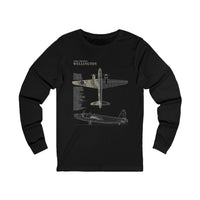
Wellington - Long Sleeve Tee
$32.00
Vickers - Armstrongs Wellington
The Wellington first flew in 1936 and entered service with the RAF in 1938 as a medium bomber and anti-submarine aircraft. Its distinctive geodetic construction, designed by Barnes Wallis, gave the bomber a greater chance of surviving anti-aircraft flak. Early in the war, Bomber Command used the Wellington for night raids before the Lancaster and Stirlings took on the role and the Wellington went on to anti-submarine duties. Just over 11,000 of these aircraft were built.
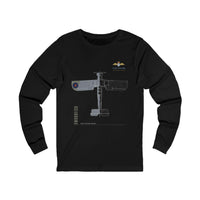
Swordfish - Long Sleeve Tee
$40.00
Fairey Swordfish
825 Naval Air Squadron took delivery of the Swordfish in 1936, replacing the Fairey Seal and Blackburn Baffin. At the start of the Second World War the FAA had 13 squadrons operating the Swordfish. Despite its age the Swordfish was an outstanding combat aircraft serving in the Norwegian campaign, in the Mediterranean and famously took part in the sinking of the Bismarck whilst operating from HMS Victorious in the Atlantic. The Swordfish remained in service until 1946, but one remains flight worthy with the Royal Navy Historic Flight.
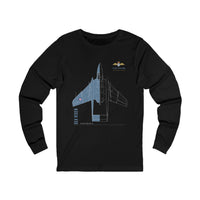
Sea Vixen - Long Sleeve Tee
$40.00
de Havilland DH. 110 Sea Vixen
The Sea Vixen was first developed in the 1940s, entering service with the Fleet Air Arm in 1959 in the fleet air defence role. The Sea Vixen was the first two-seat British aircraft to achieve supersonic speed in a dive. The type was used in anger over Tanganyika, Yemen and the Aden Emergency. In 1972 the Phantom replaced the Sea Vixen.

Sea Hawk - Long Sleeve Tee
$40.00
Hawker Sea Hawk
The Sea Hawk first flew in 1951 and entered service with the Fleet Air Arm with 806 Squadron at Brawdy before operating from HMS Eagle. The Sea Hawk saw combat service during the Suez Crisis of 1956. Six Sea Hawk squadrons took part, flying from HMS Eagle, Albion and Bulwark, and was tasked in the ground attack role. The Sea Hawk last saw service in 1960, being replaced by the Supermarine Scimitar and de Havilland Sea Vixen.
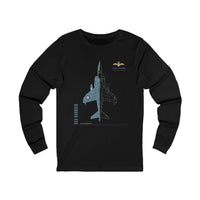
Sea Harrier - Long Sleeve Tee
$40.00
British Aerospace Sea Harrier
The first squadron to operate the Sea Harrier was 800 introduced on HMS Invincible, but was moved to HMS Hermes. The Sea Harrier played a distinctive role in the Falklands War of early 1982. Successes were 20 Argentine aircraft shot down with two losses from ground fire and four to accidents. Success can be attributed to the Sea Harrier using the latest AIM-9L Sidewinder missiles and the Blue Fox radar. The Sea Harrier was withdrawn from service in 2006 with the planned replacement being the F35 Lightning II some years later.

Phantom - Long Sleeve Tee
$40.00
McDonnell Douglas F4K Phantom
The RAF and FAA purchased the F4J and redesigned it with the Rolls-Royce Spey turbofan, installed the Ferranti AN/AWG-11 radar and redesignated it the F4K. HMS Ark Royal operated the Phantom after a major refit to accommodate the Phantom's higher weight and landing speed. The final catapult launch from Ark Royal was a Phantom of 892 at the end of 1978.
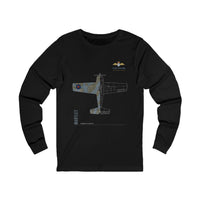
Martlet - Long Sleeve Tee
$40.00
Grumman F4F Wildcat / Martlet
The Fleet Air Arm bought the Wildcat before it was used by the US Navy, was renamed as the Martlet and replaced the Fairey Fulmar. Christmas day 1940 a Martlet shot down a Junkers Ju88 over Scapa Flow which was the first combat victory by a US built fighter in British service in World War II. Eric M 'Winkle' Brown flew the Wildcat / Martlet and commented that, "this Grumman fighter was one of the finest shipboard aeroplanes ever created".
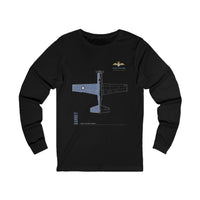
Gannet - Long Sleeve Tee
$40.00
Fairey Gannet
The Gannet first flew in 1949 and made the first deck landing of a turboprop aircraft on HMS Illustrious. The first FFA Gannet squadron was 826 on board HMS Eagle in the early warning and anti-submarine role, but by the mid 60s the Gannet switched to electronic counter measures and mail and light cargo supply. The Gannet was exported to many countries including the Royal Australian Navy, Indonesia and West Germany.
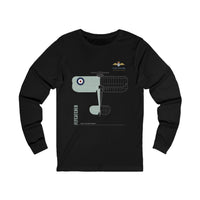
Flycatcher - Long Sleeve Tee
$40.00
Fairey Flycatcher
Built at the Fairey's Hayes factory in 1923, the Flycatcher entered service with No.402 Flight of the Fleet Air Arm. Flown from British carriers such as HMS Courageous, the Flycatcher became a versatile fighter that developed tactics that would be used later in World War II. The Flycatcher was operational with the Home, Mediterranean, East Indies and China Fleets.
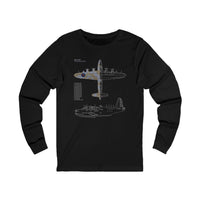
Sunderland - Long Sleeve Tee
$32.00
Short S.25 Sunderland
Built by Short Brothers, the Sunderland was used by the RAF as a flying boat patrol bomber. The S.25 first flew in 1937 and entered service in 1938. The aircraft was operated by the RNZAF right up to 1967.
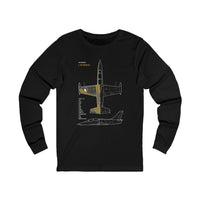
L-39 Albatros - Long Sleeve Tee
$32.00
Aero L-39 Albatros
The L-39 Albatros entered service with Czechoslovak Air Force in 1972 as a fast jet, basic and advanced trainer. Its success made it the preferred trainer for the Warsaw Pact countries as well as over 45 other Air Forces around the world.

Saab 105 - Long Sleeve Tee
$32.00
Saab 105
The Saab 105 entered service with the Swedish Air Force in 1967 as the Sk 60 and later by the Austrian Air Force as a Jet Trainer.
